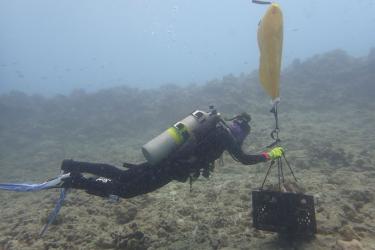We depend on the ocean for food, medicine, income, recreation, and much more. In turn, we have to balance our uses of the ocean, including fisheries, to make sure that these resources are around for future generations. Ecosystem-based management considers all impacts on and uses of the ecosystem. Managers are challenged with protecting both natural resources and human services in changing environmental conditions, such as climate and pollution, that may alter the ecosystem state, and changing regulations that impact human uses. Computer models simulate these complex interactions and can provide insights to balance ecological and economic tradeoffs for different management plans.
Atlantis: A Decision Support Tool for Ecosystem-based Management
One model is the Atlantis Ecosystem Model, which can produce realistic simulations of ecosystem dynamics. The model simulations can be used to explore ecological hypotheses, simulate different climate scenarios, and test human effects on the environment including fishing, tourism, natural resource extraction, land use, and nonpoint-source pollution. The original Atlantis code was developed by scientists at the Commonwealth Scientific and Industrial Research Organisation in Australia and has been implemented for more than 30 ecosystems worldwide.
Atlantis is an effective tool for evaluating management strategies, particularly for testing management policies and methods for coral reef conservation. We can assess management scenarios with simulations that represent ecosystems and their complexities. The model is not intended to replace traditional stock assessments or to make short-term decisions (e.g., total catch limits). Instead, it complements traditional assessments with an ecosystem approach. The Atlantis framework incorporates information on the biological, geochemical, and physical processes of a specific region or system. Atlantis integrates these dynamics, includes the effects of different user groups, and dynamically tracks the interaction of these factors over time. It also simulates the important processes of assessment, management, and compliance.

We adapted the Atlantis framework to study shallow coral reef ecosystems in Guam. Stakeholders identified the main stressors to Guam's reefs, various management strategies, as well as economic and ecological indicators to include in the model for Guam.
With the Guam Atlantis model, we can ask questions such as, "What happens with...
...increased or decreased coral cover?
...changing populations of parrotfishes, sharks, sea stars, or turtles?
...increasing or decreasing nutrient input?
...an growing human population?"
We can also ask questions about the local economy. Because Atlantis has a spatially explicit modeling approach, we can explore these types of questions island-wide and by specific areas.
Ecosystem Modeling in the Main Hawaiian Islands
Currently, we are applying the Atlantis software to the insular marine ecosystems of the main Hawaiian Islands. For example, we can use the model to evaluate ecosystem effects (social, economic, and ecologic) of the commercially-important bottomfish fishery and of changes in the Hawaiian monk seal population. Additionally, we can evaluate climate impacts and how ocean acidification will alter ecosystem dynamics. Ocean acidification degrades coral reefs, negatively affecting reef fishes that use that ecosystem as their habitat, which in turn will affect the recreational and cultural fishing practices, but also indirectly affects human communities. Since the model includes bi-directional dynamics, we can identify the direct and indirect effects of climate change on human well-being, and on the ecosystem structure and resilience, and evaluate socio-ecological tradeoffs of different management strategies.

Conceptual Ecosystem Modeling in West Hawai'i
Human communities are a key component of ecosystems. To better understand coastal ecosystems on the local level and contribute to ecosystem-based management overall, we work with models that include social and cultural factors alongside ecological and biological information. In West Hawai'i, an especially complex and dynamic marine ecosystem, we asked stakeholders to provide input on ecosystem threats and services and then diagrammed the connections in a conceptual ecosystem model.
This model presents a way to apply ecosystem-based management that is both locally-specific and transferable to other locations. Local resource management can better assess the ecosystem pressures that stakeholders specifically identify as influential and important. Critical information can emerge through this process. For example, cultural ecosystem services, which are critical to society yet not often incorporated in management strategies, were perceived by participants as the most vulnerable to ecosystem change in West Hawai'i. Increasing our understanding of these intangible benefits to communities will be a critical step toward integrating them into resource management.

Size-based food web modeling with therMizer

Ecopath with Ecosim (EwE) models how energy moves through the food web from phytoplankton to apex predators. Species-specific diets are the backbone of this model, so it's important to know which species are predators, and which species they prey on, in order to make the model as accurate as possible. We can use EwE to understand how a change in one species will affect all the other species in the ecosystem. We can also use EwE to examine how fisheries and ecosystems interact.




